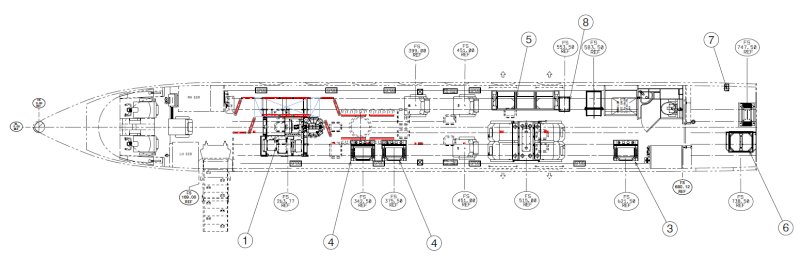NARVAL 2

Next Generation Remote Sensing for Validation Studies
Mission status: Completed
Persons in Charge
Mission-PI
- Bjorn Stevens, MPI-M, Hamburg
- Felix Ament, Universität Hamburg, Meteorological Institute (MI), Hamburg
Mission coordinator
Lutz Hirsch, MPI-M, Hamburg
Contact point at DLR-FX for this mission:
HALO Project Management: Katrin Witte
Postal address:
DLR Oberpfaffenhofen
Flugexperimente (FX)
Münchener Str. 20
82234 Weßling
Germany
Office phone:
+49 (0)8153 28-1357
HALO Deployment Base
Time Period
June 20 – Aug 31, 2016
| Mission phase | Dates |
|---|---|
| Payload integration | 20 Jun 2016 - 15 Jul 2016 |
| EMI test flight | 18 Jul 2016 - 22 Jul 2016 |
| Instrument tests (on ground) | 25 Jul 2016 - 5 Aug 2016 |
| Ferry flight Oberpfaffenhofen-Barbados | 8 Aug 2016 |
| Mission in Barbados | 8 Aug 2016 - 31 Aug 2016 |
| Ferry flight Barbados-Oberpfaffenhofen | 31 Aug 2016 |
| Campaign end. (Payload remains integrated for following NAWDEX mission.) | 31 Aug 2016 |
Project description
What role does convective aggregation play in climate – this is one of four key questions formulated by the World Climate Research Program (WCRP) initiative Grand Science Challenge on Clouds, Circulation and Climate Sensitivity. Moist convection can be organized in very different ways – from randomly scattered shallow clouds up to mesoscale cloud clusters or even large-scale systems affecting the planetary circulation. There is evidence both from observations and from numerical simulations that the degree of organization affects the overall stratification of the atmosphere: an atmosphere in which convection is more aggregated is drier, clearer and, thus, more efficient at radiating energy to space. Recent numerical studies have established the concept of self-aggregation which occurs even without any external driver. This process might intensify with increasing temperature and may, thus, be sensitive to climate change. These findings are based solely on large-eddy resolving numerical simulations. Comprehensive and highly resolved observational records are needed to constrain and evaluate such numerical simulations.
NARVAL 2 will contribute to this very timely issue by analyzing organized convection in the deep tropics in the vicinity of Barbados. This region is designated by weak external forcing. HALO will be stationed at Barbados for a four weeks period in August 2016 to perform targeted observations of organized connective systems. If possible, we will follow each system by a series of flights at subsequent days to trace the systems life cycle. The focus will be on non-rotating systems, since up to now they have been paid less attention to compared to larger systems evolving into Hurricanes. We intend to describe both the organization of the convection itself as well as the status of the ambient boundary layer. Disentangling the relation between convective aggregation and boundary layer evolution is an important key to assess the climate sensitivity of organized convection.
Stationing HALO on Barbados close to the target area minimizes the time of transfer flights and allows flying at moderate altitude to enhance the sensitivity of all remote sensing instruments. In addition we will benefit from technical and scientific experience of the South part of the first NARVAL campaign. NARVAL 2 will expand the statistics of the first campaign and will again broaden the long-term measurement program of the Barbados cloud observatory by adding a spatial component. The campaign will be led by the Max-Planck-Institute for Meteorology, which envisions investing 100 flight hours. The instrumentation will be identical to the first NARVAL campaign to reuse the certifications and the well-proven setup. However, the campaign is open to other groups and can be expanded by related science topics and contributions.
NARVAL 2 is closely related to NAWDEX, which will take part in autumn 2016 using exactly the same aircraft configuration. The missions feature also a scientific overlap: NAWDEX will study cyclones as mature convective systems over the extratropical Northern Atlantic. Expanding the science questions of NARVAL 2 to other regimes and different regions will support the WCRP Grand Science Challenge on Clouds, Circulation and Climate Sensitivity initiative effectively.
Partners
- Max Planck Institute for Meteorology, Hamburg
- German Aerospace Center, Institute of Atmospheric Physics (DLR-IPA)
- University Hamburg
- University of Cologne
- Leipzig University
- Ludwig-Maximilians-Universität München (LMU)
- Caribbean Institute for Meteorology and Hydrology (CIMH)
Scientific instruments and payload configuration
List of scientific instruments for the mission:
| Scientific instrument acronym | Description | Principal investigator | Institution |
|---|---|---|---|
| HAMP | HALO Microwave Package | Felix Ament Bjorn Stevens | Univ. Hamburg MPI-M |
| WALES | Water Vapour Differential Absorption Lidar | Andreas Fix Martin Wirth | DLR-IPA |
| HALO-SMART | Spectral Modular Airborne Radiation Measurement System | Manfred Wendisch | Leipzig Uni. |
| HALO-DS | DLR Dropsonde System | Stefan Kaufmann | DLR-IPA |
| specMACS | Hyperspectral Cloud and Sky Imaging | Bernhard Mayer | Univ. München (LMU) |
| BAHAMAS incl. SHARC | HALO Basic Data Acquisition System incl. Humidity Measurement | Andreas Giez | DLR-FX |
Cabin and exterior configuration of HALO for the mission

HALO cabin layout for NARVAL-2/NAWDEX

HALO exterior configuration for NARVAL-2/NAWDEX
Halo flights for this mission
| Aircraft registration | Date | Take off - Landing / UT | Total flight time / h | From - To | Mission # |
|---|---|---|---|---|---|
| D-ADLR | 2016-07-19 | 11:12:00 - 13:29:00 | 2.283 | EDMO - EDMO | 0 |
| D-ADLR | 2016-08-08 | 08:12:00 - 18:51:00 | 10.650 | EDMO - TBPB | RF01 |
| D-ADLR | 2016-08-10 | 11:52:00 - 20:02:00 | 8.167 | TBPB - TBPB | RF02 |
| D-ADLR | 2016-08-12 | 11:43:00 - 19:37:00 | 7.900 | TBPB - TBPB | RF03 |
| D-ADLR | 2016-08-15 | 11:47:00 - 19:46:00 | 7.983 | TBPB - TBPB | RF04 |
| D-ADLR | 2016-08-17 | 14:47:00 - 23:08:00 | 8.350 | TBPB - TBPB | RF05 |
| D-ADLR | 2016-08-19 | 12:28:00 - 20:52:00 | 8.400 | TBPB - TBPB | RF06 |
| D-ADLR | 2016-08-22 | 13:16:00 - 20:57:00 | 7.683 | TBPB - TBPB | RF07 |
| D-ADLR | 2016-08-24 | 12:43:00 - 20:55:00 | 8.200 | TBPB - TBPB | RF08 |
| D-ADLR | 2016-08-26 | 13:43:00 - 20:54:00 | 7.183 | TBPB - TBPB | RF09 |
| D-ADLR | 2016-08-30 | 09:42:00 - 19:52:00 | 10.167 | TBPB - TBPB | RF10 |
More information
No additional information available at this time.
Press releases, media etc
Press releases and stories
Nationnews Barbados, 24-Aug-2016
Research aircraft to study climate change. For the next few days Barbados will be part of the fight to understand global warming. A 26-member team of scientists, pilots and flight technicians from the High Altitude and LOng Range (HALO) Research Aircraft will be stationed at the Grantley Adams International Airport.
Read more.. (in English)
Barbados Today, 22-Aug-2016
Rainfall prediction made easier. Predicting weather systems and monitoring cloud formation will be a little easier once six German scientists on a specially equipped research aircraft are finished with the research they are conductiong on the southeast coast of Barbados.
Read more.. (in English)
Max-Planck-Institut für Meteorologie, 15-Aug-2016
Do clouds make the wind blow? Airborne investigations of the interplay between clouds and circulation. Which climate effects do clouds have? Under what conditions do they warm or cool the atmosphere? And what role do clouds play in shaping the atmospheric circulation, and hence help maintain the environment in which they grow? The field campaign NARVAL II, initiated and lead by scientists from the department The Atmosphere in the Earth System (Prof Bjorn Stevens) at the Max Planck Institute for Meteorology (MPI-M) and colleagues at the Universität Hamburg, aims to answer these questions. The NARVAL II mission started on 8 August 2016 with a ferry flight of the research aircraft HALO (High Altitude and Long Range Research Aircraft) from Oberpfaffenhofen, Germany, to Barbados.
Read more.. (in English) | Weiterlesen.. (auf deutsch)
Meteorologisches Institut München der Ludwig-Maximilians-Universität München, 08.08.2016
NARVAL-II measurement campaign over the southern Atlantic. NARVAL-II stands for the second part of the „Next generation Aircraft Remote-sensing for Validation studies“ campaign and is flown from Barbados between 8.8. and 31.8.2016. The formation of tropical convection is the area of research the campaign is aimed at. With a set of instruments (most remopte sensing) the phenomenon of aggregating low level trade cumulus convection to larger deep convection and finally tropical storms is observed.
Read more.. (in English) | Weiterlesen.. (auf deutsch)
DLR news, 7-Sep-2016
HALO in the Caribbean – tropical cloud research. What effects do tropical clouds have on our climate? Do they warm up or cool down the atmosphere? What factors do they influence? Even the latest models do not fully understand the effects of these climate-influencing ‚clouds‘. Scientists from the German Aerospace Center (Deutsches Zentrums für Luft- und Raumfahrt; DLR), together with partners from other research institutions, went to the Caribbean to investigate these questions.
Read more.. (in English) | Weiterlesen.. (auf deutsch)

HALO sitting on the apron of Grantley Adams International Airport in Bridgetown, Barbados, on August 11, 2016.
